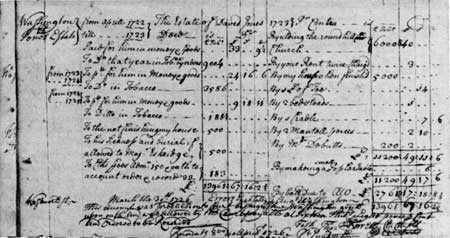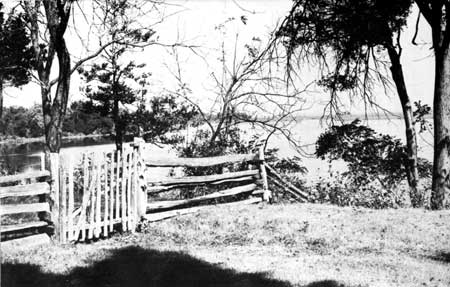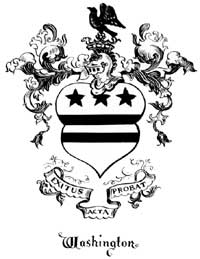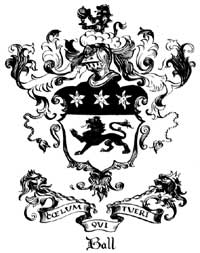|
GEORGE WASHINGTON BIRTHPLACE National Monument |
 |

Part of the court record in a suit over the
building of Washington's birthplace.
From Westmoreland Records
and Inventories, 1723—46.
Augustine Washington
EARLY LIFE. George Washington's father, Augustine Washington, was born at Mattox Creek, Westmoreland County, Va., in 1694. He remembered little of his father, as Lawrence Washington died when Augustine was only 4 years old. Two years later his mother married George Gale, and during the autumn of 1700, the family moved to England. Their family life abroad was short-lived, however, as Augustine's mother died a year later, when he was only seven. His stepfather, who seems to have been a kindly man, sent Augustine and his brother, John, to Appelby School. Their schooling, too, was cut short, for a year or two later the boys returned to Virginia to live with their elder cousin, John Washington of "Chotank," whose plantation was located on the Potomac, about 20 miles up the river from Bridges Creek. While little is known of Augustine's teen-age activities one can surmise that he enjoyed plantation life to the utmost while living with various relatives whose farms were located on the wooded south shore of the Potomac River.
FIRST MARRIAGE. Augustine Washington became of age in 1715, and shortly thereafter married Jane Butler, daughter of Caleb Butler, a successful Westmoreland County lawyer and planter. Four children were born of this union: Butler, 1716 (who died in infancy); Lawrence, 1718 (who built and named Mount Vernon); Augustine, Jr., 1719 or 1720; and Jane, 1722.

Popes Creek
PURCHASE OF POPES CREEK FARM. In 1717—18 Augustine Washington bought from Joseph Abbington 150 acres of land on Popes Creek— a beautiful tract overlooking the tidal creek and the Potomac River. Popes Creek, running along the east side of the tract, was approximately one-half mile wide, and joined the Potomac half-a-mile away. From Augustine's land the river could be seen clearly, as it was over 5 miles wide from the Virginia side to the distant Maryland shore. Augustine's historic piece of property is described in Westmoreland Deeds and Wills:
All that one hundred and fifty acres of lands scituate in the said County of Westmoreland aforesd and hounded Viz. Beginning at a marked hiccory on the head of the dancing marsh and so running down the said line to Popes Creek thence up the said Creek to the line of Nathaniel Washingtons and then up that line to include the aforesd One hundred and fifty acres of land which was given to Lawrence Abbington & his daughter Lydia Abbington together . . .
The tract probably included Joseph Abbington's home, for the purchase covered "all houses, edifices, buildings, tobacco houses, fences, orchards, and gardens."
BUILDING THE BIRTHPLACE HOME. Some time between 1723 and 1725 Augustine Washington hired David Jones, a local carpenter and undertaker, to build a house on his Popes Creek property for 5,000 pounds of tobacco with extra amounts in cash for incidentals. The late Charles A. Hoppin, authority on the Washington family, believed that George's father had the brick for his new home made on the plantation grounds, the foundations built, and many timbers hewed for the building before Jones began construction of the house. Jones also contracted to build for Augustine "2 bedsteads," "1 cradle," "2 Mantoll [mantel]pieces," and "a small Poplar Table." David Jones died in 1725, before the Washington house was completed, and Augustine entered a claim against his estate asking the sum of 500 pounds of tobacco. It may be inferred that the home was completed in 1726 and was about 6 years old at the time of George's birth.

Photocopy of the signature of Augustine
Washington, father of George.
From Westmoreland Court Orders,
1731-39.
THE BIRTHPLACE. While little is known about the appearance of the home in which George was born, the foundations and cellar floors uncovered during archeological excavations revealed that it was built either partially or entirely of brick. Several foundations of outbuildings were unearthed, and all were constructed of brick. So, also, all walls, cellar stairways, wine vaults, and fireplaces that have been excavated were built of brick.
The location of the new home was superb, being on a rise of ground 26 feet above Popes Creek and a little over 200 feet inland from its high western bank. To the east and northeast were pretty water views; to the north, beyond cleared fields, was Dancing Marsh, green with lush grass and swamp plants; and to the southeast, 100 yards or so away, was a little peninsula which jutted out into Popes Creek (now heavily wooded with a beautiful grove of eastern redcedar, Juniperus virginiana).. To the west of the house were pastures and cleared fields, and beyond the clearings was the dense forest—a mixed stand of broadleaf trees and evergreens. A farm road ran in a north westerly direction for a mile or so, passing by the family burying ground where rested Augustine's father and grandfather and other early members of the family. A short distance beyond the burying ground the road came to an end at the sandy south shore of the Potomac River.
The new home must have been rather commodious for a 1762 inventory of its furnishings lists 10 bedsteads, 13 tables, 57 chairs, 8 mirrors, 8 chests, accessories for 8 fireplaces, and scores of other furnishings and household items befitting a fairly large establishment. Certainly, the house in which George was born could not have been the humble 1-story clapboard structure portrayed in 19th-century imaginative sketches by artists who probably knew little about the social and economic status of George's father.
Though not a man of great wealth, Augustine was able to send two sons to England for schooling. Early 18th-century objects unearthed near the foundations of his Popes Creek home, offer ample proof that he imported fine quality silver, pewter, glassware, and pottery from the mother country, and could afford to have his monogram stamped on his wine bottles. He was a man of some influence in his community, having held at various times the positions of justice of Westmoreland County Court, captain in the county militia, sheriff of Westmoreland County, and a vestryman of his church. He was part-owner of two iron-furnaces—Accokeek in Virginia and Principio in Maryland—and was financially able to visit England on two occassions to deal directly with his partners. He owned land and buildings in 3 Virginia counties and was master of at least 49 slaves. Though not as wealthy as certain other planters in the Northern Neck (the tidewater counties lying between the Potomac and Rappahannock Rivers), he was a man of good social standing.
Jane Butler Washington did not enjoy the new Popes Creek home many years, for in 1729 (when only 30) she died, leaving Augustine with the care of the 3 children. Lawrence, the eldest, was only 11.
 Washington family coat of arms. |
 Ball family coat of arms. |
SECOND MARRIAGE. Sixteen months after Jane's death, Augustine married another young lady from the Northern Neck, Mary Ball, on March 6, 1731. Mary was born at "Epping Forest" in Lancaster County, and was left an orphan at the age of 12. Between that time and the day of her marriage to Augustine Washington (when she was 23) she had lived with two prominent Westmoreland County families—the George Eskridges and the Samuel Bonums. George Eskridge, a kindly guardian, was like a real father to Mary and it is believed that she later named her first-born child after him.
Following her marriage to Augustine, Mary moved to his Popes Creek home where his 3 children were in need of their new mother. She soon gained the respect of her stepchildren—Lawrence 13, Augustine 12, and Jane about 9. Accustomed to farm life, Mary quickly assumed her new duties as mistress and manager of the household, and time passed quickly for her.
As February 1732 approached, Augustine and Mary Washington knew that their first son or daughter soon was to join the family. What they did not know was that their beloved first born would be a son who, one day, would become the first President of the United States of America—an office and a nation not yet dreamed of by any man. They did not know that their tiny son's deeds and character would, in time, make him an immortal figure in the history of the new nation. Nor did they know that, before 200 years would pass, a city given his name would be the capital of a great World Power.
VIRGINIA IN 1732. In 1732, 125 years had passed since the founding at Jamestown of the first successful English colony in America. The county of Westmoreland had been established for 79 years, and three-quarters of a century had gone by since Augustine's grandfather, John Washington, had settled in Virginia. Williamsburg had been the capital of the colony for 33 years, and William and Mary College was in its 40th year. Some of Augustine's older friends remembered Bacon's Rebellion, which had flared up and had been extinguished by Governor Berkeley 56 years earlier. Augustine himself certainly remembered news of the fight between Blackbeard's pirates and Virginia sailors, for only 14 years had gone by since the ruthless pirate leader had been killed off Ocracoke Island on the Outer Banks of North Carolina. Augustine also remembered accounts of the expedition Governor Spotswood had led to the distant Blue Ridge Mountains in 1716, for this adventuresome exploit was still discussed by the tidewater planters who coveted the little-known lands beyond the distant mountains.
There were only two towns in Virginia of any considerable size— Williamsburg, and Norfolk—by 1732. The population of the colony was estimated at 114,000, of which 76,000 were whites and 38,000 Negroes. George Gooch was Lieutenant Governor of the Royal Province and George II was in the 6th year of his reign.
In 1732 William Byrd of "Westover" and Peter Jones were surveying the North Carolina-Virginia boundary line, and another year was to go by before Petersburg and Richmond would be laid out as townsites. There was not a single newspaper in Virginia in 1732; Augustine may have read The Maryland Gazette (published in Annapolis by W. Parks at 15 shillings a year) or one printed in London.
Tobacco was the important money crop, and almost every ship that sailed from a plantation wharf carried hogsheads of the "delightful weed" in its hold. Many other commodities too, were shipped to the mother country as well as to New England, the middle colonies, Barbados, Madeira, Bermuda, and Jamaica. Exports from one Virginia shipping district—Porth South Potomac—in 1732 included (besides tobacco) staves, timber, corn, wheat, peas, beans, masts, pig iron, feathers, pork, cotton, earthernware "parcels," woodenware "parcels," bacon, hides, deerskins, beaver skins, oak and walnut logs, cider and cider casks, beef, wine pipes, snakeroot, tallow, pewter and brass "parcels," and copper ore casks. Items imported included rum, salt, Irish linen, fish, chocolate, molasses, sugar, earthernware, "woodware," millstones, Madeira wine, cheese, rice, ironware, and "parcels from Great Britain." The latter "parcels" included furniture fabrics, rugs, pottery and porcelain, silver, pewter, copper and brassware, and other household furnishings and accessories needed by the colonists.

|
|
Last Modified: Mon, Jan 20 2003 10:00:00 pm PDT |


